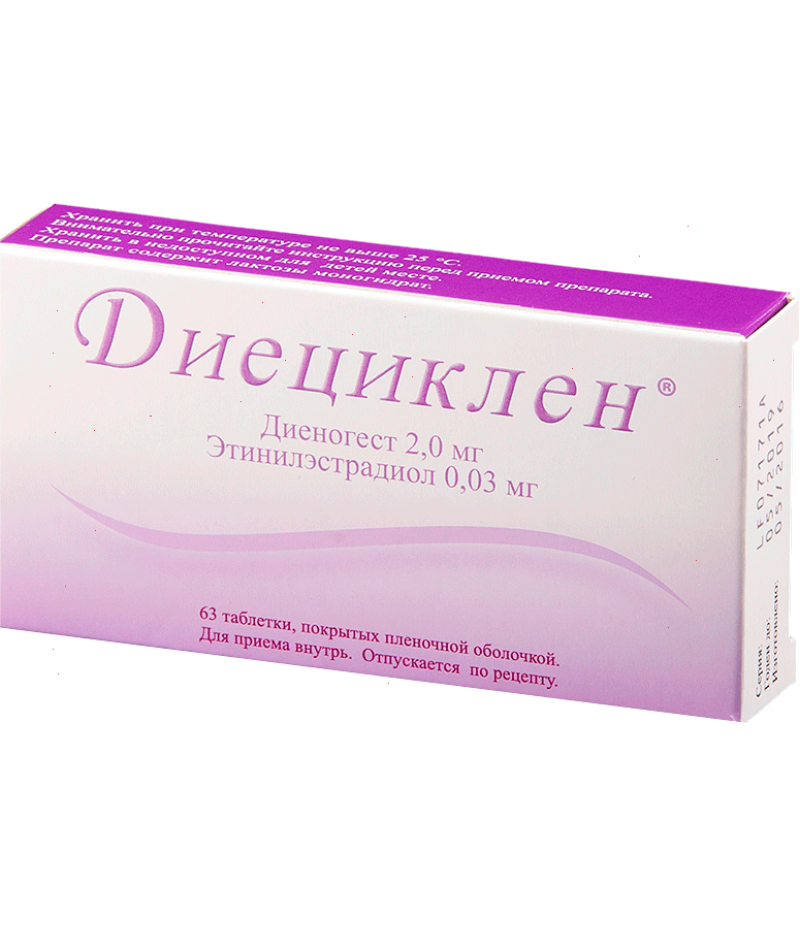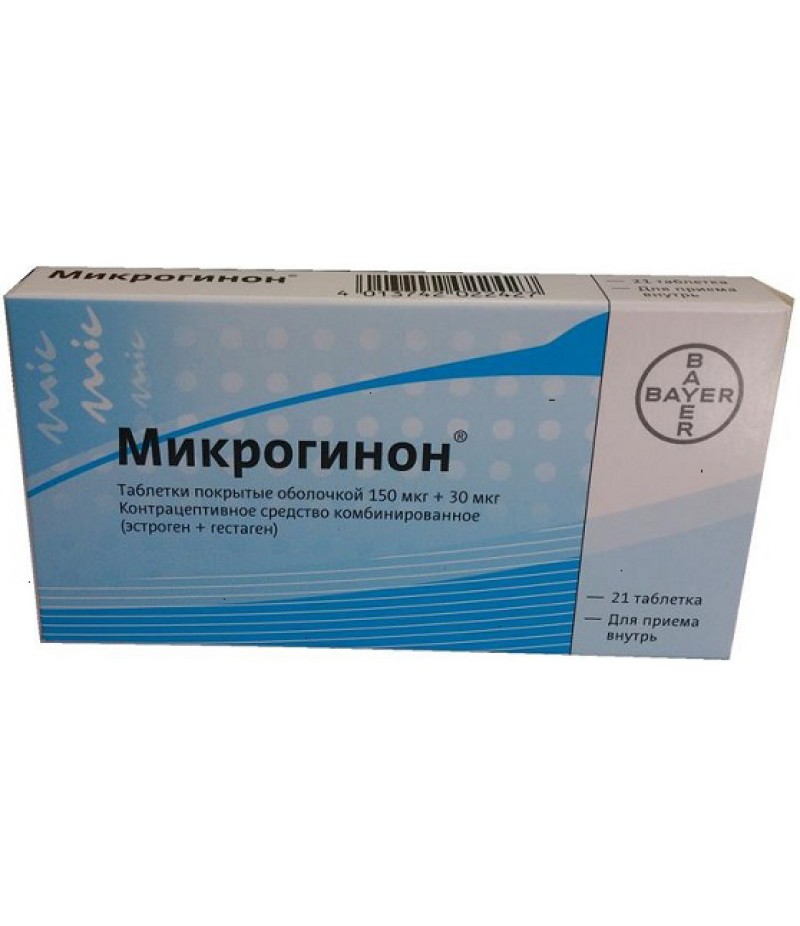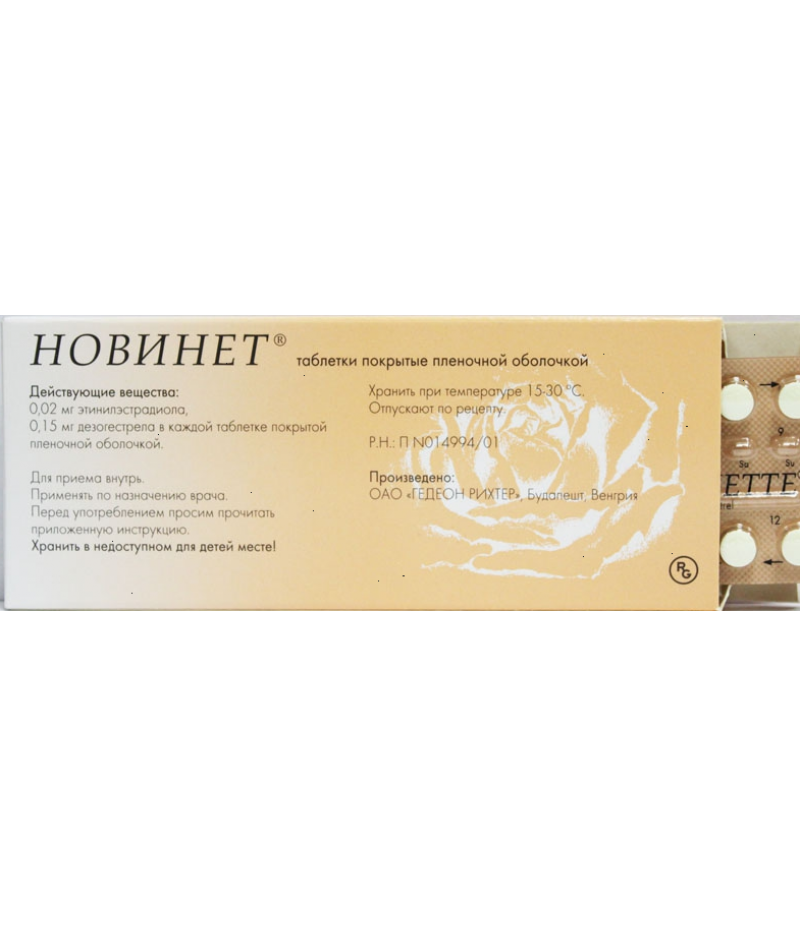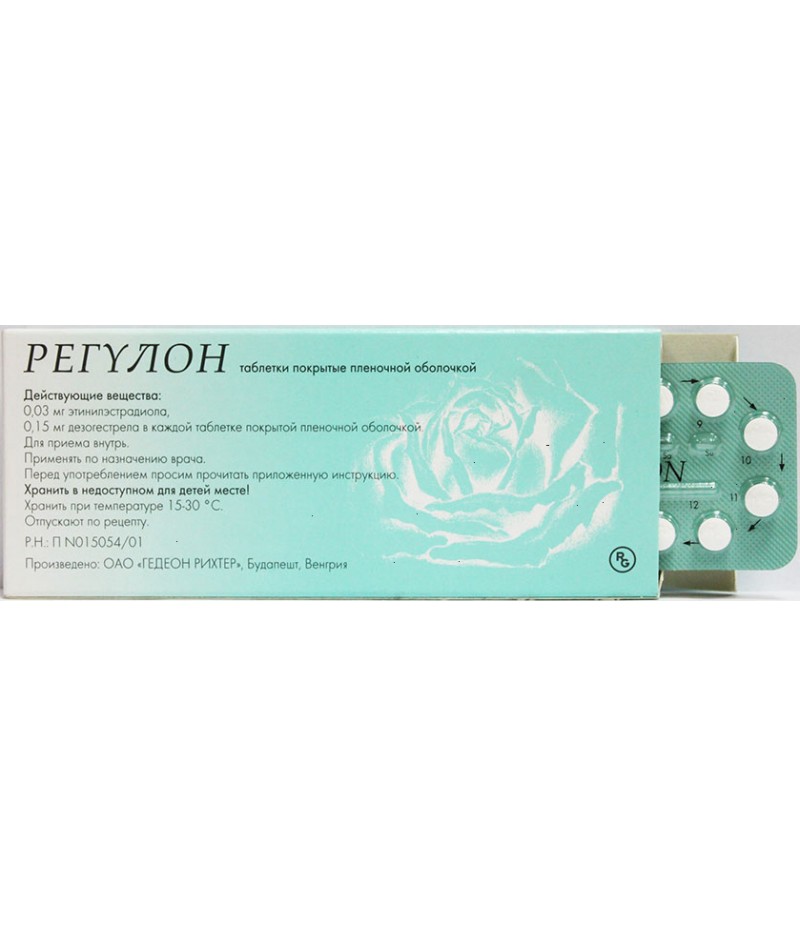Diecyclen tabs 2mg + 0.03mg #63
- $57.94
- 2 or more $57.20
- 3 or more $55.99
- Availability:In Stock
Diecyclen instruction for useReed more and buy Diecyclen on this pageComposition1 tablet contains:Active substances: ethinyl estradiol 0.03 mg; Dienogest 2 mg.Packaging21 tablets.pharmachologic effectDécyclen is a low-dose monopha..
Tags: tabs
Diecyclen instruction for use
Reed more and buy Diecyclen on this page
Composition
1 tablet contains:
Active substances: ethinyl estradiol 0.03 mg; Dienogest 2 mg.
Packaging
21 tablets.
pharmachologic effect
Décyclen is a low-dose monophasic oral hormonal contraceptive. The contraceptive effect is based on the interaction of various factors, the most important of which is the inhibition of ovulation and changes in the viscosity of cervical mucus, with the result that it becomes impermeable to spermatozoa, penetration of sperm through the cervical canal is difficult. If used correctly, the Pearl Index (a measure reflecting the number of pregnancies in 100 women using a contraceptive during the year) is less than 1. If you skip pills or misuse, the Pearl index may increase.
In addition to the contraceptive effect, it has other associated positive properties. In women taking combined oral contraceptives, the cycle becomes more regular, soreness, intensity and duration of menstrual bleeding decrease, resulting in a reduced risk of iron deficiency anemia. There is also evidence of a reduction in the risk of endometrial and ovarian cancer.
The gestagein component dienogest, which is part of the preparation, is an active gestagen, is a derivative of nortestosterone with antiandrogenic activity and has a positive effect on the lilide profile, increasing the concentration of high density lipoproteins (HDL).
Pharmacokinetics
Ethinyl estradiol
When ingested quickly and completely absorbed. The maximum concentration of estradol in the blood plasma (about 67 pg / ml) is reached in 1.5-4 hours. After absorption and the effect of "first passage" through the liver, ethinyl estradiol is metabolized, its absolute bioavailability with oral administration is about 44%.
Ethinyl estradiol largely binds to serum albumin (approximately 98%) and induces the synthesis of globulin, sex hormone-binding hormone (HSPG), in blood plasma. The volume of distribution of ethinyl estradiol is about 2.8-8.6 l / kg.
Ethynilzstradiol undergoes presystemic conjugation in both the mucous membrane of the small intestine and in the liver. The main metabolic pathway is aromatic hydroxylation with the formation of a variety of hydroxylated and methylated derivatives in the form of free metabolites, glucuronide metabolites and sulfates. The rate of clearance from blood plasma is approximately 2.3-7 ml / min / kg.
Up to 30-50% of the metabolites of ethinilzstradiol and excreted by the kidneys, 30-40% - through the intestines. The half-life of zstradiol (T1 / 2) does not exceed 10 hours after a single dose of 1 tablet and rises to 15 hours after 3 cycles of taking Diecyclen.
The equilibrium concentration of ethynylstradiol in the blood plasma with regular intake is achieved in the second half of the cyclic administration of the drug.
Dienogest
When ingested quickly and almost completely absorbed. The maximum concentration of dienogest in serum (about 51 pg / ml) is reached after 2.5 hours. The absolute bioavailability of dienogest is 96%, the equilibrium concentration in the blood plasma with a constant intake is achieved after 4 days.
90% of the total plasma concentration of dienogest is associated with serum albumin, but does not bind with SHBG, or corticosteroid-binding globulin. In unbound form is 10% of the total concentration of dienogest in plasma. The volume of distribution of dienogest is about 37-45 l.
Metabolized mainly by hydroxylation, but also by hydrogenation, conjugation and aromatization with the formation of inactive metabolites. After taking a single dose, the total clearance of dienogest is about 3.6 l / h.
After receiving a dose of 0.1 mg / kg, the ratio of excretion of dienogest in the form of metabolites by the kidneys and through the intestine is 3: 1. Only a small amount of unchanged dienogest is excreted by the kidneys. The half-life (T1 / 2) of dienogest is approximately 8.5-10.8 hours. After oral administration, 86% of the dose of dienogest is eliminated within 6 days; a significant part of it is excreted in the first 24 hours after administration, mainly by the kidneys.
Equilibrium concentration. Induction of ethinyl estradiol olom of globulin synthesis does not affect the pharmacokinetics of dienogest. With daily use of Diecyclen, the concentration of dienogest in serum increases 1.5 times.
Diecyclen, indications for use
Oral contraception; treatment of mild to moderate acne and seborrhea.
Contraindications for Diecyclen
- hypersensitivity to any of the components of the drug Diecyclen;
- thrombosis (venous and arterial) and thromboembolism at present or in history (including deep vein thrombosis, pulmonary embolism, myocardial infarction, stroke, cerebrovascular disorders);
- conditions preceding thrombosis (including transient ischemic attacks, angina pectoris) at present or in history;
- multiple or pronounced risk factors for venous or arterial thrombosis, including complicated lesions of the valvular apparatus of the heart, atrial fibrillation, vascular diseases of the brain or coronary arteries; uncontrolled arterial hypertension, volume surgical intervention with prolonged immobilization, smoking over the age of 35, obesity with a body mass index of> 30 kg / m2;
- diabetes mellitus with diabetic angiopathy;
- identified susceptibility to venous or arterial thrombosis, including resistance to activated protein C, deficiency of antithrombin III, deficiency of protein C, deficiency of protein S, hyperhomocysteinemia, antibodies to phospholipids, lupus antigen;
- severe liver disease (until the restoration and normalization of laboratory parameters of liver function);
- benign or malignant liver tumors, incl. in the anamnesis;
- severe forms of arterial hypertension with blood pressure> 160/100 mm Hg;
- identified hormone-dependent malignant diseases of the genitals or mammary glands, or suspicion of them, incl. in the anamnesis;
- bleeding from the vagina of unknown origin;
- migraine with focal neurological symptoms at present or in history;
- pancreatitis, accompanied by severe hypertriglyceridemia now or in history;
- severe and / or acute renal failure;
- pregnancy or suspicion of it;
- lactation period;
- hereditary lactose intolerance, lactase deficiency or glucose-galactose malabsorption syndrome or hypersensitivity to peanuts or soy (due to the presence of lactose and soy lecithin in the composition of the drug Diecyclen).
Carefully
Risk factors for thrombosis and thromboembolism, obesity, smoking, dislipoproteinemia, hypertension, migraine without focal neurological symptoms, diseases of the heart valves, prolonged immobilization, major surgery, major trauma, genetic predisposition to thrombosis (thrombosis, myocardial infarction or cerebrovascular accident in young age from any of the closest relatives).
Other diseases in which violations of the peripheral circulation can be observed: diabetes mellitus without diabetic angiopathy, phlebitis of superficial veins, systemic lupus erythematosus (SLE), hemolytic uremic syndrome, Crohn's disease, ulcerative colitis, sickle cell anemia.
Diseases that first occurred or worsened during pregnancy or against the background of previous sex hormones, for example, jaundice and / or itching against cholestasis, gall bladder disease, porphyria, Sydenhem's chorea, herpes during pregnancy in history, hearing loss (associated with otosclerosis ).
Endogenous depression, epilepsy; hereditary angioedema; hypertriglyceridemia; liver disease; postpartum period.
Dosage and administration
Inside, daily, preferably at the same time, in the order indicated on the package, with a small amount of water. Take 1 tablet per day continuously for 21 days. Taking the pills from each of the next package begins after a 7-day break, during which there is a "withdrawal" bleeding (menstrual-like bleeding). It usually starts 2-3 days from taking the last pill and may continue until the beginning of taking the pill of a new package.
In the absence of taking any hormonal contraceptives in the previous month, taking Diecyclen begins on the first day of the menstrual cycle (on the first day of menstrual bleeding). It is allowed to start taking on the 2-5 day of the menstrual cycle, but in this case it is recommended to additionally use a barrier method of contraception during the first 7 days of taking the tablets from the first package.
When switching from the previous administration of other combined oral contraceptives, it is preferable to start taking the drug the next day after taking the last active pill from the previous package, but not later than the next day after the usual 7-day break in taking (for drugs containing 21 tablets) or after taking the last one. inactive tablets (for drugs containing 28 tablets per pack).
When switching from the vaginal ring of a transdermal patch, it is preferable to start taking the drug Diecyclen on the day the ring or patch is removed, but no later than the day when a new ring is to be inserted or a new patch is pasted.
When switching from contraceptives containing only gestagens (“mini-pili”, injection forms, implant), Diecyclen is taken: from “mini-pili” - on any day (without a break), from the implant - on the day of its removal, from the injection form - from the day when the next injection should have been given. In all cases, you must use an additional barrier method of contraception during the first 7 days of taking pills.
After an abortion in the first trimester of pregnancy, you can start taking immediately. Subject to this condition, there is no need for additional contraceptive protection.
After childbirth or abortion in the second trimester of pregnancy, it is recommended to start taking the drug Diecyclen on days 21-28 after giving birth or abortion. If reception is started later, you must use an additional barrier method of contraception during the first 7 days of taking the pills. However, if a woman has already had a sexual life, pregnancy should be excluded before the start of medication, or it is necessary to wait for the first menstruation.
Recommendations in the case of irregular administration of the drug Diecyclen:
If a drug is missed, if the delay in taking the pill was less than 12 hours, the contraceptive protection is not reduced. It is necessary to take a pill as soon as possible, the next pill is taken at the usual time. If the delay in taking the pill is more than 12 hours, contraceptive protection can be reduced.
In the first 2 weeks of taking Diecyclen, if the interval since taking the last pill is more than 36 hours: you need to take the last missed pill as soon as possible (even if it means taking 2 tablets at the same time). The next pill is taken at the usual time. Additionally, a barrier method of contraception (condom) should be used within the next 7 days. If there was sexual intercourse within 1 week before the pill was missed, the likelihood of pregnancy should be considered. The more pills are missed and the closer this pass to the 7-day break in taking the drug, the higher the risk of pregnancy.
At 3 weeks of taking Diecyclen, if the interval since taking the last pill is more than 36 hours: you need to take the last missed pill as soon as possible (even if it means taking 2 tablets at the same time). The next pill is taken at the usual time. Additionally, a barrier method of contraception (condom) should be used within the next 7 days. In addition, taking the pill from a new package should be started as soon as the current package is finished. nonstop. Most likely, the "withdrawal" bleeding will not be until the end of taking the pills from the second package, but there may be a "spotting" discharge or a uterine bleeding "breakthrough" on the days of taking the pills.
If a woman misses a pill and then during a break in taking the drug she has no "withdrawal" bleeding, it is necessary to exclude pregnancy.
In gastrointestinal disorders:
If a woman has vomiting or diarrhea within 3 to 4 hours after taking the drug Diecyclen absorption may be incomplete. In this case, it is necessary to focus on the recommendations regarding the omission of the pill. If a woman does not want to change the normal mode of taking Diecyclen, she should take an extra pill from a spare pack, if necessary.
Change the day of the onset of menstrual bleeding:
To delay the onset of menstrual bleeding, it is necessary to continue taking the pills from the new package immediately after all the pills from the previous one are taken, without interruption in administration. Tablets from a new package can be taken until the package is finished. On the background of taking the drug from the second package, women may experience "spotting" discharge or uterine bleeding "breakthrough." Resume taking Diecyclen from the new pack should be after the usual 7-day break.
In order to postpone the day of the onset of menstrual bleeding to another day of the week, it is necessary to shorten the closest interruption in taking Diecyclen tablets for as many days as you need to postpone the day of the onset of menstrual bleeding. The shorter the interval, the higher the risk of no bleeding "cancellation" and the appearance of further "spotting" secretions and bleeding "breakthrough" while taking tablets from the second package (as well as in the case of delaying the onset of menstrual-like bleeding).
Use during pregnancy and lactation
Diecyclen drug is contraindicated during pregnancy. In the event of pregnancy, you should immediately stop taking oral contraceptives.
If necessary, the use of the drug during lactation is necessary to solve the issue of termination of breastfeeding.
special instructions
Irregular intake can lead to acyclic bleeding and reduce the contraceptive effectiveness of Diecyclen.
Before starting or resuming the use of the drug, it is recommended to conduct a thorough general medical and gynecological examination (including examination of the mammary glands and cytological examination of a scraping from the cervix), to exclude pregnancy. In addition, violations of the blood coagulation system should be excluded. When using Diecyclen, it is necessary to carry out preventive control examinations at least once every 6 months.
The drug Diecyclen does not protect against HIV infection (AIDS) and other sexually transmitted diseases.
Diseases of the cardiovascular system:
Venous thromboembolism (VTE) may occur in the form of deep vein thrombosis and / or pulmonary embolism when using hormonal contraceptives. The approximate frequency of VTE in women taking oral contraceptives with a low dose of estrogen (less than 50 μg of ethinyl estradiol) is up to 4 per 10 thousand women per year compared to 0.5–3 per 10 thousand women not using oral contraceptives. However, the frequency of VTE, developing when taking combined oral contraceptives, is less than the frequency of VTE associated with pregnancy (6 per 10 thousand pregnant women per year).
In women taking combined oral contraceptives, extremely rare cases of thrombosis of other blood vessels, such as liver, mesenteric, renal arteries and veins or veins and retinal arteries, have been described. The relationship of these cases with the reception of combined oral contraceptives has not been proven. A woman should stop taking Diecyclen and consult a doctor if symptoms of venous or arterial thrombosis develop, which may include unilateral pain in the lower limb and / or edema; sudden severe chest pain; with or without radiation in the left hand; sudden shortness of breath; sudden bouts of coughing; any unusual, severe, prolonged headache; increased frequency and severity of migraine; sudden partial or complete loss of vision; diplopia; inarticulate speech or aphasia; dizziness; collapse with or without partial seizure; weakness or a very significant loss of sensitivity, suddenly appearing on one side or in one part of the body; movement disorders; "sharp" belly.
The risk of thrombosis (venous and / or arterial) and thromboembolism increases: with age, among smokers (with an increase in the number of cigarettes smoked or with increasing age, the risk further increases, especially in women older than 35 years), with a family history or arterial thromboembolism ever with close relatives or parents at a relatively young age), obesity, dyslipoproteinemia, arterial hypertension, valvular heart disease, prolonged immobilization, extensive surgical intervention, any operation on the lower limbs or extensive trauma, atrial fibrillation.
With prolonged immobilization, in the case of a serious surgery, any surgery on the legs or an extensive injury, it is advisable to stop using the drug (in the case of the planned operation, at least 4 weeks before it) and not to resume taking it within 2 weeks after the end of immobilization.
The question of the possible role of varicose veins and superficial thrombophlebitis in the development of venous thromboembolism remains controversial. The increased risk of thromboembolism in the postpartum period should be considered.
Disorders of microcirculation can also be observed in diabetes mellitus, SLE, hemolytic-uremic syndrome, Crohn's disease, ulcerative colitis, and sickle cell anemia.
Tumors:
The most important risk factor for cervical cancer is persistent HPV infection. There are reports of some increase in the risk of cervical cancer with prolonged use of combined oral contraceptives. However, the relationship with the reception of combined oral contraceptives is not proven. The possibility of the relationship of these data with screening for diseases of the cervix uterus and with the characteristics of sexual behavior (more rare use of barrier methods of contraception) is discussed.
A meta-analysis of 54 epidemiological studies has shown that there is a slightly increased relative risk of developing breast cancer diagnosed in women who are currently taking oral oral contraceptives (relative risk 1.24). The increased risk gradually disappears within 10 years after discontinuation of these drugs. Due to the fact that breast cancer is rarely observed in women under 40 years old, an increase in the number of breast cancer diagnoses in women who are currently taking or taking a combined oral contraceptive pill is insignificant relative to the overall risk of the disease. The relationship between the development of breast cancer and the intake of combined oral contraceptives has not been proven. The observed increase in risk may also be a consequence of careful observation and earlier diagnosis of breast cancer in women using combined oral contraceptives. In women who have ever used combined oral contraceptives, earlier stages of breast cancer are detected than in women who have never used them.
In rare cases, on the background of the use of combined oral contraceptives, benign development was observed, and in extremely rare cases, malignant liver tumors, which in some cases led to life-threatening intra-abdominal bleeding. In the event of severe abdominal pain, enlargement of the liver or signs of intra-abdominal bleeding, this should be considered when conducting a differential diagnosis.
Other states:
Women with hypertriglyceridemia or its family history may have an increased risk of developing pancreatitis with combined oral contraceptives.
Although a small increase in blood pressure (BP) has been reported in many women taking combined oral contraceptives, clinically significant increases have been rare. The relationship between taking combined oral contraceptives and increasing blood pressure has not been established. However, if persistent, clinically significant arterial hypertension develops at the time of taking them, it is advisable to cancel combined oral contraceptives and treatment of arterial hypertension. Reception of combined oral contraceptives can be continued if normal blood pressure values are achieved with the help of antihypertensive therapy.
Effect on the menstrual cycle:
When combined oral contraceptives are used, irregular (acyclic) bleeding (“spotting” spotting or “breakthrough” bleeding) may occur, especially during the first months of use. Therefore, any irregular bleeding should be assessed only after an adaptation period of approximately 3 cycles.
If irregular bleeding recurs or develops after previous regular cycles, a thorough examination should be performed to rule out malignant neoplasms or pregnancy.
Some women may not develop “withdrawal” bleeding during a break in the pill. If combined oral contraceptives were taken in accordance with the instructions, then pregnancy is unlikely. However, if combined oral contraceptives were not taken regularly, or if there are no two withdrawal bleedings, then pregnancy should be avoided.
Impact on laboratory test scores:
The use of oral combined contraceptive drugs may affect the results of some laboratory tests, including biochemical blood tests (indicators of liver function, thyroid, kidney and adrenal glands, concentration of transport proteins in blood plasma (such as HSPG), carbohydrate metabolism, lipid / lipoprotein fractions) , as well as indicators of coagulation and fibrinolysis. However, changes in these indicators remain within the normal range.
Influence on the ability to drive vehicles and mechanisms:
There are no data on the negative effect of Diecyclen on the ability to drive vehicles and to engage in potentially hazardous activities requiring increased concentration and psychomotor speed.
Interaction
Some drugs can increase the metabolic clearance rate of sex hormones and lead to severe bleeding or reduce the contraceptive effect of Diecyclen. Similar effects are characteristic of drugs that induce microsomal liver enzymes: hydantoin, barbiturates, primidone, carbamazepine and rifampicin. There are also assumptions regarding rifabutin, efavirenz, nevirapine, oxcarbazenin, topiramate, felbamate, ritonavir, nelvinafir, fizeofulvin, and also drugs containing St. John's wort (Hypericum perforatum).
Some antibiotics that reduce the enterohepatic circulation of estrogen (such as ampicillin or tetracycline) reduce the effectiveness of combined oral contraceptives.
Women taking short courses (maximum 1 week) of the above drugs should resort to additional contraceptive measures (eg, barrier method) during the simultaneous use of drugs and in the next 7 days.
With simultaneous use of oral contraceptives with rifampicin, additional contraceptive measures should be used (for example, barrier method) during the simultaneous use of drugs and in the next 4 weeks after discontinuation of treatment. If the packaging of oral contraceptives ends before the completion of the course of using other drugs, the tablets from the next package of the drug should be started without interruption.
It is necessary to increase the dose of contraceptives with a long-term course of treatment with drugs that induce microsomal liver enzymes. If side effects develop (for example, irregular menstruation) or if Diecyclen is not effective, other non-hormonal contraceptives should also be used. Oral contraceptives can affect the metabolism of some other drugs. Accordingly, this can lead to an increase (cyclosporine) or a decrease (lamotrigine) of their concentration in the plasma or tissues.
Dienogest is a substrate of cytochrome P450 (CYP3A4). Known inhibitors of CYP3A4, such as antifungal drugs (for example, ketoconazole), cimetidine, verapamil, macrolides (for example, erythromycin), diltiazem, antidepressants and grape-foot juice, can increase the concentration of dienogest in blood plasma.
Overdose
Possible symptoms of an overdose of the Diecyclen drug: nausea, vomiting, irregular bleeding, no menstrual bleeding.
If necessary, symptomatic therapy is carried out.
Terms of sell
You don't need a prescription to buy Diecyclen.




